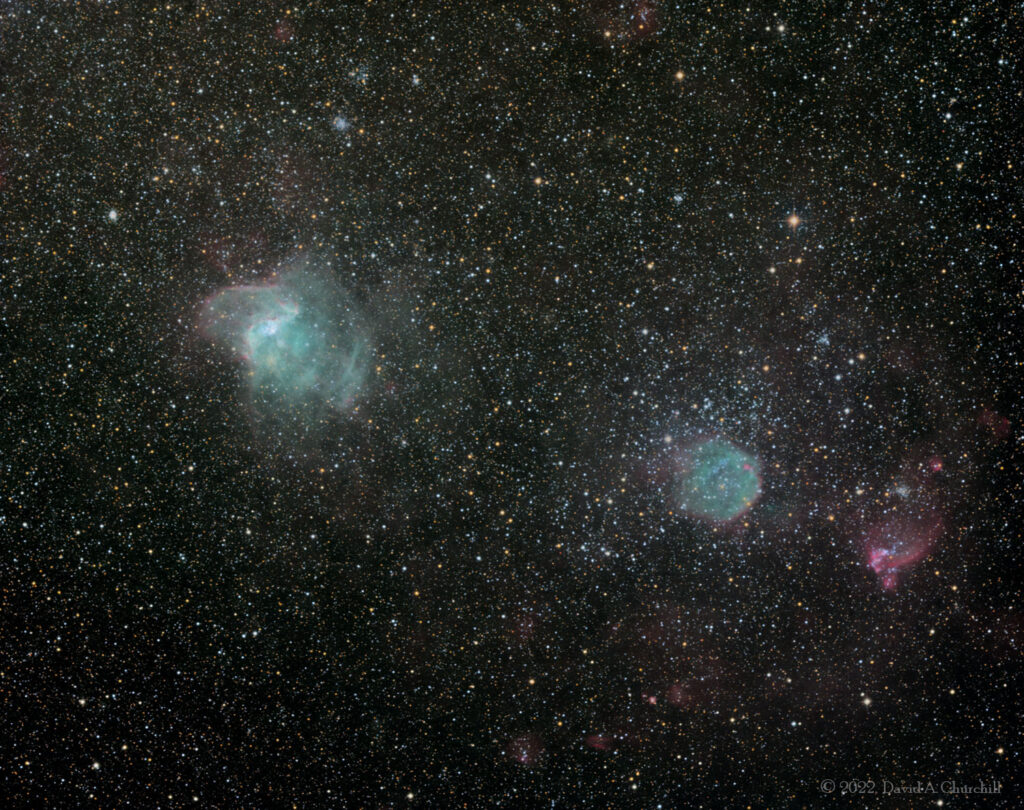NGC 346, NGC 371 & NGC 395
Open Clusters with Nebulosity, Small Magellanic Cloud, Tucana
- Description
- Technical
- Links
NGC 346 is a young open cluster of stars with associated nebula located in the Small Magellanic Cloud (SMC) that appears in the southern constellation of Tucana. It can be seen to the left of center in my image. It was discovered August 1, 1826 by Scottish astronomer James Dunlop. J. L. E. Dreyer described it as, “bright, large, very irregular figure, much brighter middle similar to double star, mottled but not resolved”. On the outskirts of the cluster is the multiple star system HD 5980, one of the brightest stars in the SMC.
This cluster is located near the center of the brightest H II region in the SMC, designated N66. This is positioned in the northeast section of the galactic bar. Stellar surveys have identified 230 massive OB stars in the direction of this cluster. 33 of the cluster members are O-type stars, with 11 of type O6.5 or earlier. The inner 15 pc radius of the cluster appears centrally condensed, while the area outside that volume is more dispersed. The youngest cluster members near the center have ages of less than two million years, and observations suggests the cluster is still engaged in high mass star formation. The cluster star formation rate is estimated at (4±1)×10−3 M☉ yr–1.
NGC 371, also called Hodge 53, is an open cluster 200,000 light-years (61,320 pc) away located in the same region and can be seen on the right of center in my image. The nebulae associated with NGC 346 and NGC 371 both appear bluish in my image.
NGC 395 is another open cluster located in the same region. It was discovered on August 1, 1826 by James Dunlop. It was described by Dreyer as “very faint, pretty large, round, gradually a little brighter middle.” In my image it is located on the lower right most edge, and is associated with the red emission nebula.
This cluster is located near the center of the brightest H II region in the SMC, designated N66. This is positioned in the northeast section of the galactic bar. Stellar surveys have identified 230 massive OB stars in the direction of this cluster. 33 of the cluster members are O-type stars, with 11 of type O6.5 or earlier. The inner 15 pc radius of the cluster appears centrally condensed, while the area outside that volume is more dispersed. The youngest cluster members near the center have ages of less than two million years, and observations suggests the cluster is still engaged in high mass star formation. The cluster star formation rate is estimated at (4±1)×10−3 M☉ yr–1.
NGC 371, also called Hodge 53, is an open cluster 200,000 light-years (61,320 pc) away located in the same region and can be seen on the right of center in my image. The nebulae associated with NGC 346 and NGC 371 both appear bluish in my image.
NGC 395 is another open cluster located in the same region. It was discovered on August 1, 1826 by James Dunlop. It was described by Dreyer as “very faint, pretty large, round, gradually a little brighter middle.” In my image it is located on the lower right most edge, and is associated with the red emission nebula.
Telescope: Planewave CDK17 (FR) f4.5
Mount: Astro Physics 1600GTO
Camera: QHY16200A/ Integral FW
Guider: Agena Starguide II / ZWO ASI178MM
Filters: Astronomik 36mm LRGB
L: 48×10 mins = 480 mins, R: 24×10 mins = 240 mins, G: 24×10 mins = 240 mins, B: 24×10 mins = 240 mins
Total Imaging Time: 20h 00m
Data Imaged remotely over 7 nights during September 2022.
Imaged from Observatorio El Sauce, Chile, in partnership with Fred Espenak.
Data acquisition & Processing by David Churchill.
None

